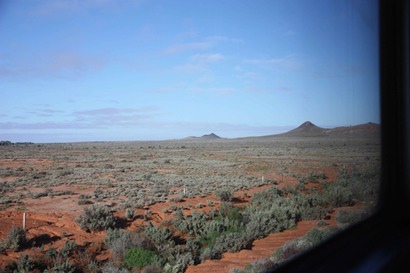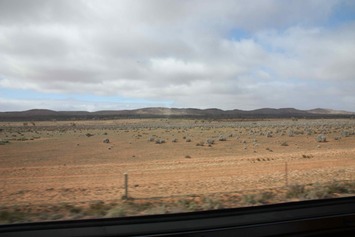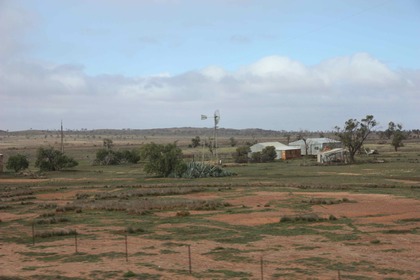
It's hard to tell where you are in a landscape without landmarks so I can't say where I spotted what may well have been an approaching shower. Our approach, however, differed, and we seemed to be skirting around any falling wetness. The scattered green pick on dry earth, however, suggested that we might have been a tad late and the extensive patches of significant erosion suggested that when moisture did condescend to condense, it took its share of dirt with it.

I spotted earth dams that were obviously man-made which, though dry as we passed, were obviously there to capture the runoff, along with a raised earth dam wall and evidence of something that looked a lot like contour ploughing or a near relative thereof, evidence that suggested the landscape, though largely bare at the moment, was being exploited.
Presumably the exploitation involved grazing, and I wasn't sure where we were in relation to the Goyder Line. I noticed a homestead where the machinery included something that looked like a device used for cultivating the soil, though whether the item in question was a working device rather than a surviving relic of earlier endeavours was impossible to determine. Crossing a bitumen road where the tarmac was still wet about ten minutes out of Peterborough it was obvious that we were into country that had, at some point in the recent past, been cultivated, and in some places the track-side reservoirs had already started filling with runoff.

Peterborough itself marks one of three points in the area where three separate rail gauges meet. The first set of tracks to arrive was the railway from Port Pirie to Broken Hill, followed by the line linking Adelaide to Alice Springs by way of Quorn (the old Ghan) both of which were narrow gauge (3 feet 6 inch) lines. Before the launch of the Indian-Pacific, the line from Broken Hill was converted to standard gauge (4 feet 8 1⁄2 inch), and the line south of Peterborough to Terowie to broad gauge (5 feet 3 inch). You apparently get the same mix of gauges at Gladstone and Port Pirie.
While Peterborough must have been a thriving community back in the day it presented a much bleaker aspect through the contemporary mizzle. While the weather reduced visibility to a couple of hundred metres the landscape increasingly showed the benefits of recent rain and the agricultural side of things became increasingly obvious, with grain silos in substantial towns. Not substantial of populations running into the thousands, but somewhere more than a dozen or two in a township that boasted a roadhouse, a pub and something else. More...